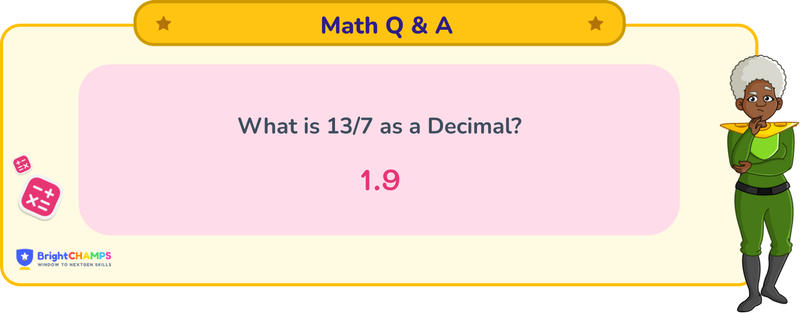
 188 Learners
188 LearnersLast updated on May 26th, 2025

13/7 as a Decimal

It is a simple question on decimal conversion. Firstly, we have to understand fractions and decimals. A fraction represents a part of a whole. It has two parts: the numerator (the number on the top), here 13, represents how many parts out of the whole are being considered. The denominator (the number below) shows how many parts make up the whole, here it is 7. A decimal is a way to represent a number that is not whole, using a (.) or decimal point to separate the whole part from the fractional part. The numbers to the left of the decimal point represent the whole, and those to the right represent the fractional part.
What is 13/7 as a decimal?

Answer
13/7 in decimals can be written as approximately 1.857142857... It is a recurring decimal, meaning it will repeat a sequence of digits infinitely.
Explanation
To convert 13/7 into a decimal, we will use the division method. Here, 13 is larger than 7, so we can divide directly. Let's see the step-by-step breakdown of the process:
Step 1: Identify the numerator and denominator because the numerator (13) will be taken as the dividend, and the denominator (7) will be taken as the divisor.
Step 2: Divide 13 by 7. 7 goes into 13 once, so we place 1 in the quotient place and subtract 7 from 13 to get 6.
Step 3: Bring down a 0 to make it 60. Divide 60 by 7, which is 8 times, giving us 56. Subtract 56 from 60 to get 4.
Step 4: Bring down another 0 to make it 40. Divide 40 by 7, which is 5 times, giving us 35. Subtract 35 from 40 to get 5.
Step 5: Bring down another 0 to make it 50. Divide 50 by 7, which is 7 times, giving us 49. Subtract 49 from 50 to get 1.
Step 6: Continue this process, and you will see the decimal repeats as 1.857142857...
This process shows that 13/7 is a recurring decimal.
Struggling with Math?
Get 1:1 Coaching to Boost Grades Fast !

Important Glossaries for 13/7 as a decimal
- Fraction: A numerical quantity that is not a whole number, representing a part of a whole.
- Decimal: A number that uses the base ten and includes a decimal point to separate the whole part from the fractional part.
- Numerator: The top part of a fraction, indicating how many parts of the whole are being considered.
- Denominator: The bottom part of a fraction, showing how many parts make up a whole.
- Recurring Decimal: A decimal in which a sequence of digits repeats infinitely.




